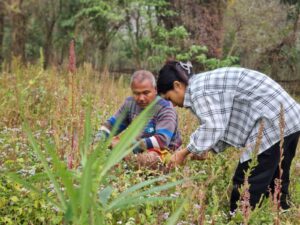Physical Address
23,24,25 & 26, 2nd Floor, Software Technology Park India, Opp: Garware Stadium,MIDC, Chikalthana, Aurangabad, Maharashtra – 431001 India
Physical Address
23,24,25 & 26, 2nd Floor, Software Technology Park India, Opp: Garware Stadium,MIDC, Chikalthana, Aurangabad, Maharashtra – 431001 India

“Just the planting of saplings isn’t enough. One has to water them, nurture them and ensure they grow into trees. Only then does it make a difference to the environment,” said the Forest Man of India- Padmashree Jadav Payeng during an exclusive interview with Climate Fact Checks. His daughter, the Secretary of the Forest Man Foundation and the recipient of the Sanctuary Asia Young Naturalist Award, 2022, Munmuni Payeng echoed her father’s words while speaking to Climate Fact Checks on the eve of the recently observed Earth Day, 2023. She said that to her, these plants and trees are like her siblings and she will go out of her way to care for them as the planet will turn uninhabitable if the green cover vanishes.
Here are some excerpts from the interview:
Jadav Molai Payeng who painstakingly nurtured for over three decades and brought to life a lush green forest on a barren 550-acre sandbar of the mighty Brahmaputra River in Assam has been an inspiration to many others from all over the world who are now following his footsteps and doing their bit to conserve greenery and save the planet.
His home and surrounding areas are situated on the flood-prone banks of the river and during his childhood, he once encountered the carcasses of numerous snakes washed ashore during such flooding. He realized that they had died as they had nowhere to hide from the scorching sun and that was all the push he needed to start bringing about a change. He discussed the issue with the village elders who suggested planting bamboo trees and asked him to contact the forest department.
It was in 1979, that he quit school and decided to plant bamboo saplings in the sandbar, around the same time that the social forestry office of the state’s Golaghat District launched an experimental tree-planting initiative on 200 hectares at Aruna Chapori to prevent flood and soil erosion. This project took place over a five-year period, and Molai quickly agreed to work on it. Later, he continued working even though the project had technically ended and the other workers had left. He had envisioned a lush, pure tropical woodland and knew he had to keep at it if he wanted it to turn into a reality.
Today, after 40 years of his continuous efforts, his forest has an area of about 1,360 acres per 550 hectares approximately the size of 15 football stadiums. To honour Payeng for his environmental activism, the forest was named “Molai Kathoni” after him.
It is now home to Bengal tigers, Indian rhinoceroses, over 100 deer and rabbits, monkeys, and many other species of birds, including a sizable number of vultures. The thousands of trees include valcol, arjun (Terminalia arjuna), Pride of India (Lagerstroemia speciosa), royal poinciana (Delonix regia), silk trees (Albizia procera), moj (Archidendron bigeminum), and cotton trees (Bombax ceiba). More than 300 hectares (700 acres) are covered in bamboo.
His legacy is now being carried forward by his 25-year-old daughter, Munmuni. She has been working on a rewilding project with the support of locals who share her family’s vision of nurturing a forest of one million native trees on sandbars close to the Molaikathoni Forest. She gives directions to the environmental and social actions of communities residing adjacent to the forest. She is also a founder member of Seuj Dhoroni (Green Earth), a grassroots organisation that promotes nature protection.
Erosion, a motivating factor to plant more trees in the region
According to statistics from the Assam state administration, the state lost 4,270 square kilometres of land to erosion between 1950 and 2017. Nearly 32,000 square kilometres, or roughly 40%, of Assam’s land, is classified by India’s National Flood Commission as being flood-prone and so susceptible to erosion. The Assam government’s Brahmaputra Board has implemented measures like building dykes and embankments to prevent erosion and floods. However, these are primarily localised, short-term structural interventions, and they have had mixed results.
A recent study that compared the plant diversity and carbon stocks of the Molai forest with a natural forest of a similar age, demonstrates that a mixed tree species plantation in the deteriorated floodplains of the Brahmaputra can be a workable, nature-based solution to address the effects of flood and erosion. Mixed species were used to grow the Molai forest on the deteriorated sandbars along the section of the Brahmaputra river. Payeng demonstrated that “when carrying out plantations, the administration should only go ahead with local species”. Bringing new species into the forest “will disturb the natural plantation in the area which later led to problems like man-elephant conflict”.
One man changed the fate of a stretch of barren, eroded land to a fully-fledged forest. Payeng’s story only goes to show how small steps can create big impacts sometimes.
Sources:
https://steemit.com/india/@arcjen/the-forest-man-of-india
https://www.oneearth.org/reforestation-hero-jadav-payeng/
http://www.vpmthane.org/bnb/Dr%20Payeng.pdf
https://www.sanctuarynaturefoundation.org/award/munmuni-payeng
https://thefederal.com/features/jadav-payeng/?amp